Beanstalk Blues
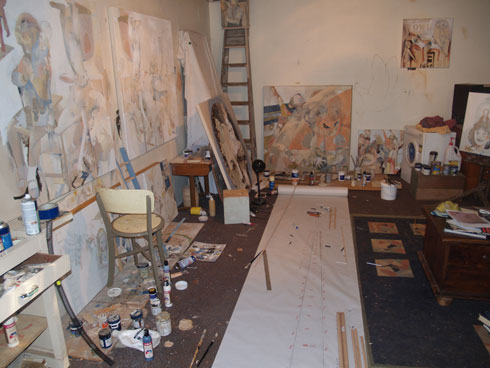
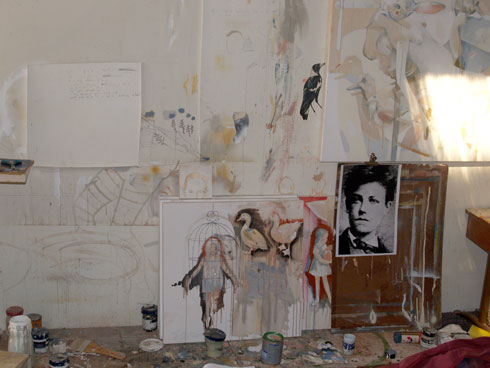
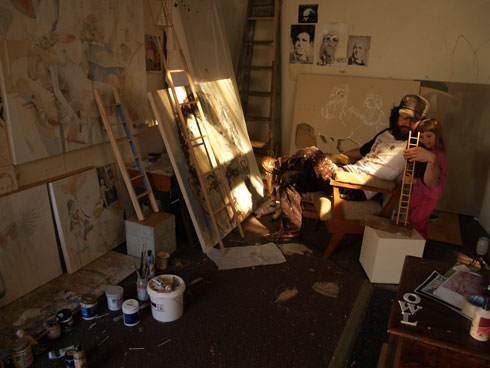
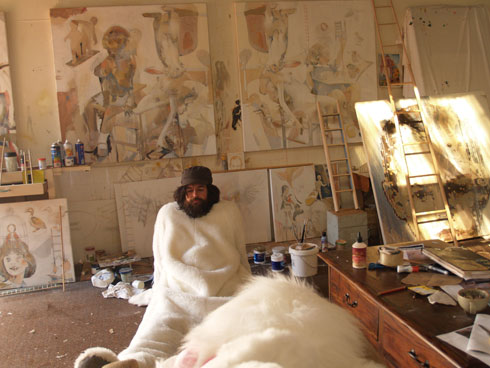
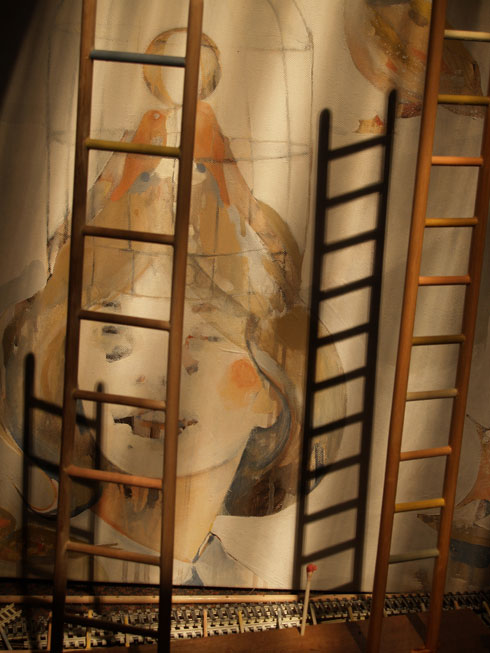
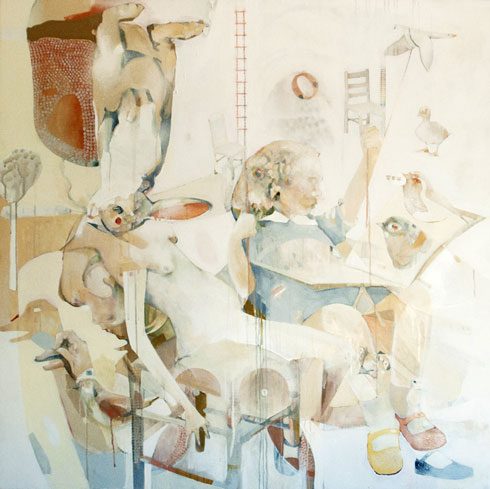
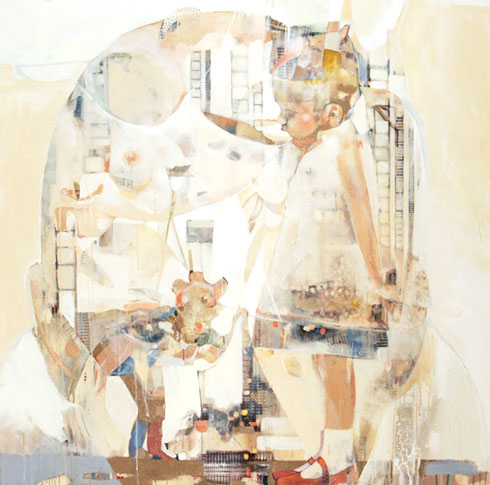
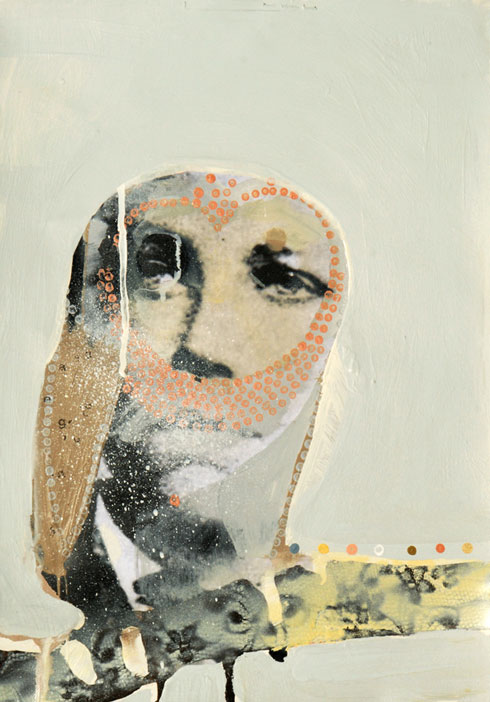 Text: Gabriel Knowles Images: Arthouse Gallery
Text: Gabriel Knowles Images: Arthouse Gallery
Damien Kamholtz’s work could be classified in two ways. On one hand there’s the literal side, the side we see though his work with community groups in rural Queensland and Central Austrilia where he coaxes expression from children. On the other hand there’s his personal practice, an amalgamation of abstraction, totemic icons and the exploration of personal themes on a grand scale. Gabriel Knowles caught up with Damien to discuss universal consciousness and other lighthearted matters.
Gabriel Knowles: So what have you been up to?
Damien Kamholtz: I’m having a nice period of relief at the moment actually. I’ve just been working really intensively on this show for the last few months so it’s nice to have a bit of a break now and catch up on a few things.
GK: How long do you work on a show?
DK: It depends on the amount of time I have to tell you the truth, I’ll just work to the schedule I have which really varies depending on shows. I have no idea how long works are going to take because it’s such an evolving process, sometimes they finish themselves a lot earlier than I would have thought and other times things get added and it ends up taking hours and hours more.
GK: That’s probably quite a natural process though.
DK: I think so, it’s an enjoyable process when it all comes together but sometimes with the practicalities of home life and everything it would be kind of nice to know how longs things are going to take.
GK: I guess that’s the reality of it though, if you’re working to set parameters then that would have a profound influence on your work.
DK: Yeah absolutely, i fact this show has probably been a little bit influenced by the schedule. There’s the appearance of a couple of characters that run though this exhibition, both animal symbols with particular meanings. One is the rabbit, that symbolises the rushing, with a shorter schedule this time around I think I’ve been sub-consciously in a state of rushing and having to be quick.
GK: When was your last show?
DK: In June. I think I was trying to use the stress and chaos of a schedule to fuel the work. Last year I had a show in Sydney and I had one of the major pieces in the studio to work on the whole time and I was thinking about but I didn’t start it until 10 days before the deadline. So it was a really mad 10 days of working solidly on it and because of that a different energy crept its way into the work. It was well received and I enjoyed the results so I think I sub-consciously tried to replicate that over a whole show.
GK: Do you think that has something to do with the latent ideas that you can express just yet?
DK: I think so, even when I’m painting I’m thinking and storing things. Then once you start a new body you’ve got all those ideas ready to go.
GK: How do you collate those ideas?
DK: Mostly in the back of my mind, I keep journals and lots of sketches on my studio walls. They wouldn’t mean much to anyone else but they’re triggers for me.
GK: Have you ever showed those to anyone else or are they indecipherable?
DK: Yeah they probably are! That said, my paintings are an accumulation of ideas because I don’t have an end product in mind when I begin. It adds complexity to the work that I could never pre-plan.
GK: Does that ever surprise you?
DK: It does, I just got a little work back from an exhibition I did in June the same day that my new works were leaving and the exact same shape is in two of the major works for my latest show. It was almost an exact replica.
It’s part of what I do I think, I try not to be too conscious. It’s working on a different level, less analytical and more about the aspects of yourself you don’t use in everyday life. It’s what I like about painting probably.
GK: It’s an incredible resource that we have.
DK: It is, and that’s what this show’s about in a sense. I’m exploring Jack and the Beanstalk as a central theme but it’s a metaphor for climbing that beanstalk to a different place, a bigger resource. (Carl) Jung talks about a universal consciousness that everybody has the opportunity to tap in to and that’s where a lot of ideas for mythology, stories and artworks can come from. That’s why there are so many similarities between themes from around the globe when people didn’t have contact with people in different parts of the world yet stories all had similar story lines. So I’m using that metaphor of the beanstalk to try and tap into that place.
GK: How did you get started with the workshops and gallery that you run there in Toowoomba?
DK: It all started with the birth of my first child. I was studying Visual Arts at the time and watching her pick up a pencil for the first time really excited me, I guess I was exploring abstraction at the time and watching her move a brush around really inspired me so we had an exhibition of local children’s work and it was really well received so we’ve kept offering the opportunity for them to express what they’re doing. Children are very creative but unfortunately as we grow into adults that can be lost, part of what we do is promote the importance of creativity and hang on to it through adulthood no matter what job they end up doing.
I tried to cut back my involvement to focus on my own work but I found that I like the feeling of sharing that experience with communities. It definitely all feeds back in.
GK: Who else do you do that with?
DK: It’s my wife and I primarily but we work with other artists where need be.
GK: Is it fair to say you don’t exhibit up there?
DK: No, not really. Up here I’m probably known as a community artist. I mean they know that I paint my own works but not that I show regularly where I do. I like living in a quieter place, when I’m working I just tuck myself away.
GK: And you’ll be in Sydney for your show?
DK: Yeah, it’s always nice to see they show in a gallery because the studio gets a bit claustrophobic. I also don’t necessarily get to see them side-by-side until the show.
GK: So you don’t get to see the whole story until then?
DK: I mean I see them if I move them around but I don’t get to see them as one big story until then.
GK: There are a bunch of ladders and chairs in your latest show that I assume you won’t get to see until you install the show then?
DK: Yeah, the biggest ladder will stand about four metres high in the gallery and it will be on a mirror as well so with the rabbits there’s a bit of an Alice In Wonderland theme there as well. The themes of the work at the moment are about exploring fairy tales and the use of children as symbols and metaphors. Initially the use of this as symbol was more simplified, characters were often faceless and genderless and they have just developped quite organically to how they appear in this show.
GK: Is that a subject you’ve always been interested in?
DK: Yeah that sense of storytelling has always excited me, where the concepts are large but they’re delivered simply. you see a similar thing with other artists that are influenced by American popular culture, they’re addressing personal themes that are universal. I’m just more attracted to the older European style of storytelling and aesthetic, although they’re all rooted in indigenous mythologies. Something that’s always interested me is the recurring themes across geographical distances in places that would never have had contact with each other. That taps back into what we talked about before, the idea that there’s a bigger resource that we all tap into.
GK: So what’s next on your agenda?
DK: My first task now is to work on a book publication for a children book that I am working on. I spent last year working on images to accompany the text, one of the pieces was selected in the Sulman Prize this year. It’s a story called Egon and Blue Horse – the boy who believed and it follows a characters discovery and attempts to capture a wild horse. It’s a metaphorical tale about desire and tranformation.
Beanstalk Blues is showing now at Arthouse Gallery in Sydney until October 16
Next story: All The Elements – Amber & Thomas



